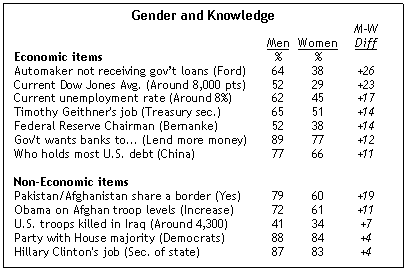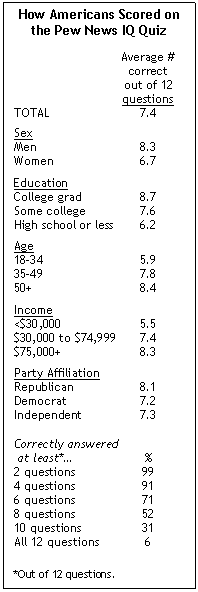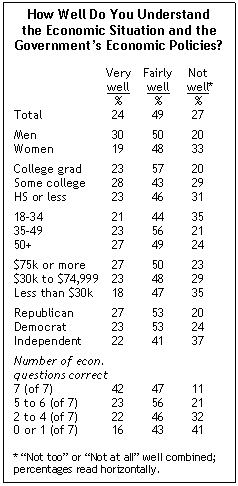Overview

The latest Pew Research Center News IQ survey finds the American public reasonably well-informed about a number of basic facts pertaining to the current economic situation. Fully 83% know that the government assistance to banks and other financial institutions is aimed at getting them to lend more money, not less money. Roughly seven-in-ten (71%) correctly identify China as the foreign country holding the most U.S. government debt.
 A majority of Americans (58%) know that Timothy Geithner serves as the treasury secretary. And 51% are aware that of the three major U.S. automakers, Ford is the one that has not received emergency loans from the government.
A majority of Americans (58%) know that Timothy Geithner serves as the treasury secretary. And 51% are aware that of the three major U.S. automakers, Ford is the one that has not received emergency loans from the government.
Notably, more Americans know the current unemployment rate than the current level of the Dow Jones Industrial Average: 53% correctly estimated the unemployment rate at about 8% (the rate was 8.1% in February, but is projected to rise to 8.5% in March). That compares with 40% who correctly estimated the level of the Dow average at about 8,000; it ranged from 7,696 to 7,925 during the survey field period. This is slightly lower than awareness of the Dow average in the Pew Research Center’s December 2008 News IQ survey, when 45% got this question right.
These are the principal findings of the latest News IQ survey by the Pew Research Center for the People & the Press, conducted March 26-29, in which 1,003 adults were asked a series of 12 multiple choice questions about events and people in the news. Respondents answered an average of 7.4 questions correctly. Seven of the survey questions were related to the economy, and respondents answered an average of four of these seven questions correctly.
Beyond the economy, the survey also addressed public awareness of some basic facts about U.S policy toward Afghanistan. Two-thirds (66%) are aware that Barack Obama has decided to increase the number of U.S. troops stationed in Afghanistan (21% believe he decided to decrease troop levels and 7% said he decided to make no changes). Roughly the same proportion (69%) responded correctly that Pakistan and Afghanistan share a border; 15% say the two countries do not share a border and 16% offered no response.
An overwhelming majority (86%) knows that Democrats hold a majority in the U.S. House of Representatives. This is up slightly from 82% in December, and is substantially higher than the 70% who correctly identified the Democrats as the majority party a year ago. Public awareness of Hillary Clinton’s current position also is widespread – 85% are aware that she is currently serving as secretary of state as opposed to some other position. By comparison, a year ago 70% knew that Condoleezza Rice was serving as the secretary of state.
Unemployment and the Dow
Among those who did not know the current unemployment rate (47% of the public), far more overestimated than underestimated its current level. Nearly a quarter (24%) said the rate is closer to 12%, and another 18% of Americans said the unemployment rate is closer to 16%. By contrast, just 3% of Americans incorrectly think the unemployment rate is lower than it actually is.
Compared with the unemployment rate, fewer Americans (40%) correctly said that the current Dow Jones  Industrial Average is around 8,000. Again, when people erred, it was in a more gloomy direction. Roughly a third of Americans (34%) say the Dow is either closer to 3,000 (20%) or 5,000 (14%), while just 4% estimated it at 11,000.
Industrial Average is around 8,000. Again, when people erred, it was in a more gloomy direction. Roughly a third of Americans (34%) say the Dow is either closer to 3,000 (20%) or 5,000 (14%), while just 4% estimated it at 11,000.
Lower income, non-employed and younger people are substantially less aware of both the unemployment rate and the Dow Jones average than are higher income, employed and older Americans. Republicans are far more likely than Democrats (52% vs. 33%) to correctly identify the current Dow Jones Industrial Average. There is less of a partisan gap when it comes to identifying the unemployment rate; 58% of Republicans and 51% of Democrats correctly identified the current unemployment rate.
Republicans More Knowledgeable
Across the 12 knowledge items tested, the biggest gap between Democrats and Republicans comes over awareness of the current level of the Dow. Republicans also are more likely to correctly name Ben Bernanke as chairman of the Federal Reserve Board and know that Tim Geithner’s position is treasury secretary. In addition, a greater percentage of Republicans than Democrats know that Obama decided to increase the number of U.S. troops in Afghanistan and that Ford is the U.S. automaker that has not taken emergency government loans.
 But there is little or no partisan gap in knowledge on some other key items: Democrats and Republicans are about equally likely to know that China holds the most U.S. debt, that Hillary Clinton is secretary of state; and that roughly 4,300 U.S. troops have been killed in Iraq.
But there is little or no partisan gap in knowledge on some other key items: Democrats and Republicans are about equally likely to know that China holds the most U.S. debt, that Hillary Clinton is secretary of state; and that roughly 4,300 U.S. troops have been killed in Iraq.
The differences in knowledge levels between Republicans and Democrats are mostly a reflection of the different demographics of the two groups. Republicans tend to be older, more educated, higher income and are more likely to be male; each of these characteristics is strongly associated with political and economic knowledge. When these characteristics are held constant – that is, when Republicans and Democrats with similar demographic characteristics are compared – there is little difference between the two groups.
Large Age Gap in Knowledge
 As in past rounds of Pew Research’s News IQ Quiz, a person’s age is closely associated with their knowledge of facts about domestic and international issues. This gap carries over to the economic realm as well.
As in past rounds of Pew Research’s News IQ Quiz, a person’s age is closely associated with their knowledge of facts about domestic and international issues. This gap carries over to the economic realm as well.
For each of the 12 items tested, a greater proportion of older people (50 and older) than younger people (younger than 35) knew the correct answer.
This gap is largest on the two questions relating to Afghanistan. Only about half (52%) of those younger than 35 know that Pakistan and Afghanistan share a border, compared with 71% of those 35 to 49, and 80% of those 50 and older. While just 47% of those younger than 35 know that Obama decided to increase troop levels in Afghanistan, substantial majorities of those 35 to 49 (69%) and 50 and older know this (79%). There also are sizable age differences in the percentages able to identify Timothy Geithner’s position, the name of the Federal Reserve Board chairman and the U.S. automaker that has not taken emergency loans from the government.
 Pew Research news consumption surveys have consistently found that higher percentages of men than women say they very closely follow politics, international affairs and economic news. The knowledge survey reflects this gap in news interests. More men than women answer most questions correctly, with particularly large gender differences evident in questions about which automaker has not taken government loans (64% of men answered correctly vs. 38% of women) and the current level of the Dow (52% of men vs. 29% of women).
Pew Research news consumption surveys have consistently found that higher percentages of men than women say they very closely follow politics, international affairs and economic news. The knowledge survey reflects this gap in news interests. More men than women answer most questions correctly, with particularly large gender differences evident in questions about which automaker has not taken government loans (64% of men answered correctly vs. 38% of women) and the current level of the Dow (52% of men vs. 29% of women).
Yet there are exceptions to this pattern. About as many women (83%) as men (87%) know that Hillary Clinton is secretary of state and that the Democrats hold the majority in the House of Representatives (84% of women, 88% of men).
News Knowledge on Average
 To measure knowledge levels, the 12 multiple choice questions in the survey were used to create a knowledge index. For each correct answer respondents were assigned one point on a scale ranging from zero (none correct) to 12 (all correct).
To measure knowledge levels, the 12 multiple choice questions in the survey were used to create a knowledge index. For each correct answer respondents were assigned one point on a scale ranging from zero (none correct) to 12 (all correct).
On average, the public correctly answered approximately seven out of 12 questions (mean 7.4, median 8). Just 6% got a perfect score by answering all 12 questions right, while 5% missed 10 or more. A large majority (71%) answered at least half the questions correctly.
Overall, those who are 50 or older answered an average of 8.4 questions correctly, while those younger than 35 answered just 5.9 questions correctly on average. College graduates fared better than those with less education: On average, college graduates correctly answered 8.7 questions correctly, while those with some college got an average of 7.6 right and those with no more than a high school education got 6.2 correct.
Men correctly answered an average of 8.3 out of 12 questions correctly; women answered an average of 6.7. Republicans received higher average scores on the quiz than both Democrats and independents. Republicans averaged 8.1 correct answers, compared with 7.3 for independents and 7.2 for Democrats.
A smaller knowledge index that included only the seven questions relating to economic conditions, economic policy and people in the news involved in many of the nation’s economic decisions, produced similar results both overall and in terms demographic differences in knowledge levels.
Understanding Economic News
 The current economic situation is, admittedly, confusing for many Americans. Prior to being asked the series of knowledge questions, people were asked to rate how well they understand the economic situation and the government’s economic policies. Roughly one-in-four (24%) say they understand the current situation and government policies very well, while 49% say they understand these things fairly well; 27% say they understand the economic situation and government policies either not too well (20%) or not at all well (7%).
The current economic situation is, admittedly, confusing for many Americans. Prior to being asked the series of knowledge questions, people were asked to rate how well they understand the economic situation and the government’s economic policies. Roughly one-in-four (24%) say they understand the current situation and government policies very well, while 49% say they understand these things fairly well; 27% say they understand the economic situation and government policies either not too well (20%) or not at all well (7%).
Self assessments are associated with the ability to answer the questions that followed in the survey. Among the minority of respondents who were able to answer all seven economic questions correctly, 42% say they understand the situation very well. By contrast, very few of those who got less than five of the seven questions correct were as positive about their understanding of the economic situation.


